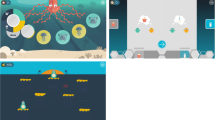Abstract
We present a field study with a game for children called ‘Tap the little hedgehog’, which is played on the TagTiles console, a tangible electronic interface. The game was developed to train and assess cognitive skills and includes tasks which, in isolation, exhibit a high correlation with a number of subtests from the Wechsler Intelligence Scale for Children (WISC-III-NL). The tasks address a range of nonverbal skills by requiring children to perform different operations on abstract patterns such as copying, reproducing sequences from memory and mirroring patterns. In the current study, we tested whether these tasks kept their ability to address these skills if included in a gaming context, whether children are able to play the game independently and whether they are motivated to play the game. The results of the study support the hypothesis that nonverbal IQ-scores, as measured by the Wechsler Intelligence Scale for Children, can improve by training with a game. Hence, games like ‘Tap the little hedgehog’ can be used to train specific skills and serve as a screening tool for these skills. The results also confirm that children can play the game independently and that they enjoy it. We further found that children quickly learn how to play the game and use the interface.








Similar content being viewed by others
References
Weiser M (1991) The computer for the twenty-first century. Sci Am 165(3):94–104
Aarts EHL, Marzano S (eds) (2003) The new everyday: visions of ambient intelligence. 010 Publishing, Rotterdam
Verhaegh J, Fontijn W, Aarts E, Boer L, van de Wouw D (2011) A development support bubble. J Ambient Intell Smart Environ 3:1–9. IOS Press, Amsterdam 2011, pp 27–35
http://www.ambrasoft.nl/school/. Retrieved 15 Oct 2011
Klingberg T, Fernell E, Olesen PJ, Johnson M, Gustafsson P, Dahlström K, Gillberg CG, Forssberg H, Westerberg H (2005) Computerized training of working memory in children with ADHD—a randomized, controlled trial. J Am Acad Child Adolesc Psychiatry 44(2):177–186
Verhaegh J, Resing WCM, Jacobs APA, Fontijn WFJ (2009) Playing with blocks or with the computer? Solving complex visual-spatial reasoning tasks: comparing children’s performances on tangible and virtual puzzles. Educ Child Psychol (Special Issue) 26(3):18–29
Manches A, O’Malley C, Benford S (2009) The role of physical representations in solving number problems: a comparison of young children’s use of physical and virtual materials. Comput Educ 54(3):622–640
Hourcade JP (2008) Interaction design and children. Found Trends Hum Comput Interact 1(4):277–392
Manches A, O’Malley C (2011) Tangibles for learning: a representational analysis of physical manipulation. Pers Ubiquitous Comput 16(4):405–419
Lathouwers E (2010) Spel in de rekenles. Internal thesis report, Serious Toys, B.V
Verhaegh J, Fontijn WFJ, Resing WCM (in prep) On the correlation between children’s performances on electronic board tasks and nonverbal intelligence test measures
Wechsler D (2005) Wechsler Intelligence Scale for Children (WISC-III-NL), Handleiding en Verantwoording, Derde Editie NL. Harcourt Assessment, London
Raven JC, Raven J, Court JH (2004, Dutch translation 2006) Manual for Raven’s progressive matrices. Harcourt Assessment B.V, San Antonio
Henning JR, Verhaegh J, Resing WCM (2011) Creating an individualized learning situation using scaffolding in a tangible electronic series completion task. Educ Child Psychol Comput Assess Contrib Educ Psychol (Special Issue) 28(2):85–100
Fontijn WFJ, Hoonhout HCM (2007) Functional fun with tangible user interfaces. In; Digitel07: 1st IEEE international workshop on digital game and intelligent toy enhanced learning
Malone TW, Lepper MR (1987) Making learning fun: a taxonomy of intrinsic motivations for learning. Aptitude Learn Instr 3:223–253
Ishihara S (2005) The series of plates designed as a test for colour deficiency, Concise edn. Kanehara Trading Inc., Tokyo
Bleichrodt N, Drenth PJD, Zaal JN, Resing WCM (1987) RAKIT (Revisie Amsterdamse Kinder Intelligentie Test). Swets & Zeitlinger, Lisse
http://www.psych.rochester.edu/SDT/measures/IMI_scales.php. Retrieved 15 Oct 2011
Stienstra M, Hoonhout J (2002) TOONS toys. Interaction toys as a means to create a fun experience. In: Proceedings of the interaction design and children conference 2002, Eindhoven. Shaker Publishing BV, Maastricht, pp 199–210
Chambers CT, Johnston C (2002) Developmental differences in children’s use of rating scales. J Pediatr Psychol 27(1):27–36
Resing WCM, Steijn WMP, Xenidou-Dervou I, Stevenson CE, Elliott JG (2011) Computerised dynamic testing: a study of the potential of an approach using sensor technology. J Cogn Educ Psychol 10(2):178–194
Ramsden S, Richardson FM, Josse G, Thomas MSC, Ellis C, Shakeshaft C, Seghier ML, Price CJ (2011) Verbal and non-verbal intelligence changes in the teenage brain. Nat Lett. Published online 19 Oct 2011
Acknowledgments
The authors would like to thank Else Vink and others for their assistance in the data collection and Kirsten Touw for her support in the data analysis. We would like to thank also Privender Saini and Maddy Janse for their valuable comments on earlier versions of this paper. We are also grateful to the children who participated in the game tests.
Author information
Authors and Affiliations
Corresponding author
Rights and permissions
About this article
Cite this article
Verhaegh, J., Fontijn, W.F.J., Aarts, E.H.L. et al. In-game assessment and training of nonverbal cognitive skills using TagTiles. Pers Ubiquit Comput 17, 1637–1646 (2013). https://doi.org/10.1007/s00779-012-0527-0
Received:
Accepted:
Published:
Issue Date:
DOI: https://doi.org/10.1007/s00779-012-0527-0




